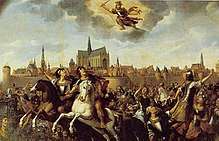Reyer van Blommendael
Reyer Jacobsz van Blommendael (27 June 1628 (baptised) – 23 November 1675) was a Dutch Golden Age painter from Haarlem.


Paris and Oenone, now at the Palais des Beaux-Arts de Lille.

Sint-Bavo Saves Haarlem
Biography
He entered the Haarlem Guild of that city in 1662, and was buried in the St. Bavochurch there where later his sister Risje (who had previously named him in her will) was also buried.[1] His sister's will from 1669 stated that he was living in Amsterdam, and her newer will from 1675 mentions him living in the Hague.
His works were attributed by Johannes Vermeer, Dirck van Baburen, Cesar van Everdingen, Abraham Bloemaert, Jan van Bronchorst and Gerard van Honthorst.
Works
- Paris and Oenone, Palais des Beaux-Arts de Lille
- Lot and His Sons, Musée des Beaux-Arts de Dunkerque, attributed
- Xantippe Dousing Socrates (c. 1655), Musée des Beaux-Arts de Strasbourg
- Saint Bavo Saves Haarlem (1673), St. Bavochurch, Harlem
Notes
- Reyer Jacobsz van Blommendael in the RKD
gollark: Well, actually, it now hangs from an end island, which itself is unsupported.
gollark: Chorus City is literally without support.
gollark: Blocks just magically float. Buildings need no reinforcement at all, you can build them from wool and glass.
gollark: Everything is perpetual motion.
gollark: `forall a. Dam a`
References

This article is issued from Wikipedia. The text is licensed under Creative Commons - Attribution - Sharealike. Additional terms may apply for the media files.